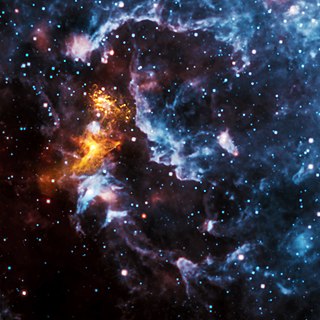Related Research Articles
"Viruses of the Mind" is an essay by British evolutionary biologist Richard Dawkins, first published in the book Dennett and His Critics: Demystifying Mind (1993). Dawkins originally wrote the essay in 1991 and delivered it as a Voltaire Lecture on 6 November 1992 at the Conway Hall Humanist Centre. The essay discusses how religion can be viewed as a meme, an idea previously expressed by Dawkins in The Selfish Gene (1976). Dawkins analyzes the propagation of religious ideas and behaviors as a memetic virus, analogous to how biological and computer viruses spread. The essay was later published in A Devil's Chaplain (2003) and its ideas are further explored in the television programme The Root of All Evil? (2006).

The Crab Nebula is a supernova remnant and pulsar wind nebula in the constellation of Taurus. The common name comes from a drawing that somewhat resembled a crab with arms produced by William Parsons, 3rd Earl of Rosse, in 1842 or 1843 using a 36-inch (91 cm) telescope. The nebula was discovered by English astronomer John Bevis in 1731. It corresponds with a bright supernova recorded by Chinese astronomers in 1054 as a guest star. The nebula was the first astronomical object identified that corresponds with a historically-observed supernova explosion.

Brugada syndrome (BrS) is a genetic disorder in which the electrical activity of the heart is abnormal due to channelopathy. It increases the risk of abnormal heart rhythms and sudden cardiac death. Those affected may have episodes of syncope. The abnormal heart rhythms seen in those with Brugada syndrome often occur at rest. They may be triggered by a fever.

Aleksander Wolszczan is a Polish astronomer. He is the co-discoverer of the first confirmed extrasolar planets and pulsar planets.

Dame Susan Jocelyn Bell Burnell is an astrophysicist from Northern Ireland who, as a postgraduate student, discovered the first radio pulsars in 1967. The discovery eventually earned the Nobel Prize in Physics in 1974; however, she was not one of the prize's recipients.
The year 1983 in science and technology involved many significant events, as listed below.
The year 1976 in science and technology involved some significant events, listed below.

Luc Montagnier was a French virologist and joint recipient, with Françoise Barré-Sinoussi and Harald zur Hausen, of the 2008 Nobel Prize in Physiology or Medicine for his discovery of the human immunodeficiency virus (HIV). He worked as a researcher at the Pasteur Institute in Paris and as a full-time professor at Shanghai Jiao Tong University in China.
PSR B1257+12, previously designated PSR 1257+12, alternatively designated PSR J1300+1240, is a millisecond pulsar located 2,300 light-years from the Sun in the constellation of Virgo, rotating at about 161 times per second. It is also named Lich, after a powerful, fictional undead creature of the same name.

PSR B1919+21 is a pulsar with a period of 1.3373 seconds and a pulse width of 0.04 seconds. Discovered by Jocelyn Bell Burnell on 28 November 1967, it is the first discovered radio pulsar. The power and regularity of the signals were briefly thought to resemble an extraterrestrial beacon, leading the source to be nicknamed LGM, later LGM-1.

A pulsar is a highly magnetized rotating neutron star that emits beams of electromagnetic radiation out of its magnetic poles. This radiation can be observed only when a beam of emission is pointing toward Earth, and is responsible for the pulsed appearance of emission. Neutron stars are very dense and have short, regular rotational periods. This produces a very precise interval between pulses that ranges from milliseconds to seconds for an individual pulsar. Pulsars are one of the candidates for the source of ultra-high-energy cosmic rays.
Dale A. Frail is a Canadian astronomer working at the National Radio Astronomy Observatory (NRAO) in Socorro, New Mexico.

Shrinivas Ramchandra Kulkarni is a US-based astronomer born and raised in India. He is currently a professor of astronomy and planetary science at California Institute of Technology, and he served as director of Caltech Optical Observatory (COO) at California Institute of Technology, in which capacity he oversaw the Palomar and Keck among other telescopes. He is the recipient of a number of awards and honours.

Robert Charles Gallo is an American biomedical researcher. He is best known for his role in establishing the human immunodeficiency virus (HIV) as the infectious agent responsible for acquired immune deficiency syndrome (AIDS) and in the development of the HIV blood test, and he has been a major contributor to subsequent HIV research.

PSR B1257+12 c, alternatively designated PSR B1257+12 B, also named Poltergeist, is an extrasolar planet approximately 2,300 light-years away in the constellation of Virgo. It was one of the first planets ever discovered outside the Solar System, and is one of three pulsar planets known to be orbiting the pulsar Lich.

PSR B1257+12 C, alternatively designated PSR B1257+12 d and also named Phobetor, is a super-Earth exoplanet orbiting the pulsar Lich approximately 2,315 light-years away from Earth in the constellation of Virgo. It was one of the first planets ever discovered outside the Solar System. It was discovered using the pulsar timing method, where the regular pulses of a pulsar are measured to determine if there is a planet causing variations in the data.
This article is a summary of the 1990s in science and technology.

The following list of publications by Richard Dawkins is a chronological list of papers, articles, essays and books published by British ethologist and evolutionary biologist Richard Dawkins.

PSR B1937+21 is a pulsar located in the constellation Vulpecula a few degrees in the sky away from the first discovered pulsar, PSR B1919+21. The name PSR B1937+21 is derived from the word "pulsar" and the declination and right ascension at which it is located, with the "B" indicating that the coordinates are for the 1950.0 epoch. PSR B1937+21 was discovered in 1982 by Don Backer, Shri Kulkarni, Carl Heiles, Michael Davis, and Miller Goss.

Pulsar planets are planets that are orbiting pulsars. The first such planets to be discovered were around a millisecond pulsar in 1992 and were the first extrasolar planets to be confirmed as discovered. Pulsars are extremely precise clocks and even small planets can create detectable variations in pulsar traits; the smallest known exoplanet is a pulsar planet.
References
- ↑ Dunbar, R. I. M. (June 1992). "Neocortex size as a constraint on group size in primates". Journal of Human Evolution . 22 (6): 469–493. doi: 10.1016/0047-2484(92)90081-J .
- ↑ Wolszczan, A.; Frail, D. A. (1992). "A planetary system around the millisecond pulsar PSR1257+12". Nature. 355 (6356): 145–7. Bibcode:1992Natur.355..145W. doi:10.1038/355145a0. S2CID 4260368.
- ↑ Dung, Vu Van; Giao, Pham Mong; Chinh, Nguyen Ngoc; Tuoc, Do; Arctander, Peter; MacKinnon, John (1993). "A new species of living bovid from Vietnam". Nature . 363 (6428): 443. Bibcode:1993Natur.363..443V. doi:10.1038/363443a0. S2CID 4243603.
- ↑ Dawkins, Richard (1992). Viruses of the Mind. 1992 Voltaire Lecture. London: British Humanist Association. Republished in 1993 in the book, Dennett and His Critics: Demystifying Mind.
- ↑ Koblas, David (September 1992), "SOCKS", Proceedings of the Third USENIX UNIX Security Symposium, Baltimore, MD: USENIX Association
- ↑ Crilly, Tony (2007). 50 Mathematical Ideas you really need to know. London: Quercus. p. 129. ISBN 978-1-84724-008-8.
- ↑ Brugada, P.; Brugada, J. (November 1992). "Right bundle branch block, persistent ST segment elevation and sudden cardiac death: a distinct clinical and electrocardiographic syndrome. A multicenter report". Journal of the American College of Cardiology . 20 (6): 1391–6. doi: 10.1016/0735-1097(92)90253-J . PMID 1309182.
- ↑ "It's been 25 years since the first-ever text message and the kids are alright". ABC News. 2017-12-02.